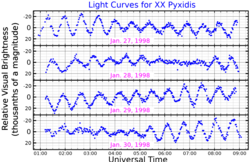XX Pyxidis is a star located in the constellation Pyxis. It has an apparent magnitude that varies slightly at about 11.5, and is about 2,300 light years away.
| Observation data Epoch J2000 Equinox J2000 | |
|---|---|
| Constellation | Pyxis |
| Right ascension | 08h 58m 39.03s[2] |
| Declination | −24° 35′ 10.6″[2] |
| Apparent magnitude (V) | 11.49[3] |
| Characteristics | |
| Spectral type | A4V + M3V[4] |
| Variable type | Delta Scuti variable[3] |
| Astrometry | |
| Proper motion (μ) | RA: −13.830[2] mas/yr Dec.: +6.985[2] mas/yr |
| Parallax (π) | 1.4301 ± 0.0341 mas[2] |
| Distance | 2,280 ± 50 ly (700 ± 20 pc) |
| Orbit[4] | |
| Period (P) | 1.15 d |
| Eccentricity (e) | 0.0 |
| Inclination (i) | 25-30° |
| Semi-amplitude (K1) (primary) | 17.8±0.4 km/s |
| Details | |
| Hot star | |
| Mass | 1.85±0.05[4] M☉ |
| Radius | 1.9[2] R☉ |
| Luminosity | 27[2] L☉ |
| Surface gravity (log g) | 4.21[2] cgs |
| Temperature | 9,431[2] K |
| Metallicity [Fe/H] | +0.09[2] dex |
| Rotation | 1.5 d[4] |
| Rotational velocity (v sin i) | 52[5] km/s |
| Age | 316[2] Myr |
| Cool star | |
| Mass | 0.3[4] M☉ |
| Other designations | |
| Database references | |
| SIMBAD | data |
XX Pyxidis is one of the more-studied members of a class of stars known as Delta Scuti variables[4]—short-period (six hours at most) pulsating stars that have been used as standard candles and as subjects to study astroseismology.[7] Astronomers made more sense of its pulsations when it became clear that it is also a binary star system. The main star is a white main sequence star of spectral type A4V that is around 1.85±0.05 times as massive as the Sun. Its companion is most likely a red dwarf star of spectral type M3V, around 0.3 times as massive as the Sun. The two are very close—possibly only 3 times the diameter of the Sun between them—and orbit each other every 1.15 days. The brighter star is deformed into an egg-shape,[4] and pulsates in several overlapping modes 26-76 times per day.[8]
References
edit- ^ Arentoft, T.; Sterken, C.; Handler, G. (September 2001). "Low-frequency variability and binarity of the δ Scuti star XX Pyx". Monthly Notices of the Royal Astronomical Society. 326 (1): 192–202. Bibcode:2001MNRAS.326..192A. doi:10.1046/j.1365-8711.2001.04594.x.
- ^ a b c d e f g h i j k Vallenari, A.; et al. (Gaia collaboration) (2023). "Gaia Data Release 3. Summary of the content and survey properties". Astronomy and Astrophysics. 674: A1. arXiv:2208.00211. Bibcode:2023A&A...674A...1G. doi:10.1051/0004-6361/202243940. S2CID 244398875. Gaia DR3 record for this source at VizieR.
- ^ a b Samus, N. N.; Durlevich, O. V.; et al. (2009). "VizieR Online Data Catalog: General Catalogue of Variable Stars (Samus+ 2007-2013)". VizieR On-line Data Catalog: B/GCVS. Originally Published in: 2009yCat....102025S. 1: B/gcvs. Bibcode:2009yCat....102025S.
- ^ a b c d e f g Aerts, C.; Handler, G.; Arentoft, T.; Vandenbussche, B.; Medupe, R.; Sterken, C. (2002). "The δ Scuti star XX Pyx is an ellipsoidal variable". Monthly Notices of the Royal Astronomical Society. 333 (2): L35–L39. Bibcode:2002MNRAS.333L..35A. doi:10.1046/j.1365-8711.2002.05627.x.
- ^ Chang, S.-W.; et al. (2013). "Statistical Properties of Galactic δ Scuti Stars: Revisited". The Astronomical Journal. 145 (5): 10. arXiv:1303.1031. Bibcode:2013AJ....145..132C. doi:10.1088/0004-6256/145/5/132. S2CID 118900730. 132.
- ^ "XX Pyxidis". SIMBAD. Centre de données astronomiques de Strasbourg. Retrieved 5 September 2015.
- ^ Templeton, Matthew (16 July 2010). "Delta Scuti and the Delta Scuti Variables". Variable Star of the Season. AAVSO (American Association of Variable Star Observers). Retrieved 5 September 2015.
- ^ Bedding, Timothy R.; et al. (2020). "Very regular high-frequency pulsation modes in young intermediate-mass stars". Nature. 581 (7807): 147–151. arXiv:2005.06157. Bibcode:2020Natur.581..147B. doi:10.1038/s41586-020-2226-8. PMID 32405022. S2CID 218613877.
